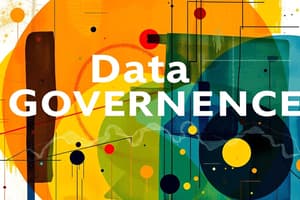Podcast
Questions and Answers
What does data governance establish policies and procedures for?
What does data governance establish policies and procedures for?
- Data security measures
- Data visualization tools
- Data analysis techniques
- Data lifecycle management (correct)
Which role plays a vital part in managing an organization's data strategy?
Which role plays a vital part in managing an organization's data strategy?
- Chief Data Officer (CDO) (correct)
- Chief Financial Officer (CFO)
- Chief Technology Officer (CTO)
- Chief Marketing Officer (CMO)
What does data governance involve in terms of data architecture?
What does data governance involve in terms of data architecture?
- Developing data architecture only
- Designing and building data models only
- Setting guidelines for data access and sharing only
- All of the above (correct)
What is NOT a part of data governance practices as mentioned in the text?
What is NOT a part of data governance practices as mentioned in the text?
Who oversees the execution of the data governance strategy within an organization?
Who oversees the execution of the data governance strategy within an organization?
How does data governance help an organization ultimately?
How does data governance help an organization ultimately?
What does data governance encompass?
What does data governance encompass?
Why is data quality important in data governance?
Why is data quality important in data governance?
What is a key aspect of data protection in data governance?
What is a key aspect of data protection in data governance?
What is an essential component for effectively managing data in organizations?
What is an essential component for effectively managing data in organizations?
Which of the following is NOT a consequence of poor data quality?
Which of the following is NOT a consequence of poor data quality?
What role does data governance play in maintaining high data quality?
What role does data governance play in maintaining high data quality?
Flashcards are hidden until you start studying
Study Notes
Data Governance: Understanding the Essential Components
Data governance refers to the strategies, guidelines, and procedures employed by an organization to manage and secure its data effectively. It encompasses aspects of data quality, protection, processes, and management. Here, we'll delve deeper into each component of data governance and how they interrelate to create a comprehensive data management strategy.
Data Quality
Data quality involves ensuring the accuracy, completeness, consistency, and timeliness of information used within an organization. Poor data quality can lead to incorrect decision-making, loss of customer trust, and potential regulatory penalties. Therefore, data governance includes setting standards and protocols for data validation, cleansing, and enhancement to maintain high data quality.
Protection
Protecting data is another vital element of data governance. This involves implementing safeguards against unauthorized access, theft, or manipulation of data. Data protection strategies include encryption, two-factor authentication, and regular backups. Additionally, data governance ensures that employees are trained in data security best practices and understand their responsibilities in keeping data safe.
Processes
Effectively managing data requires clear processes for data acquisition, storage, retrieval, and disposal. Data governance establishes policies and procedures for data lifecycle management, ensuring that data is collected efficiently, stored correctly, and made available to relevant stakeholders when needed. This includes developing data architecture, designing and building data models, and setting guidelines for how data is accessed and shared.
Management
Finally, data governance involves managing the organization's data strategy, which includes planning, oversight, and control over management of data and the use of data and related sources. A state chief data officer plays a pivotal role in this process, acting as the conductor responsible for defining and implementing the data governance strategy, overseeing its execution, and communicating its value to other parts of the organization.
By incorporating these components into its data governance practices, an organization can enhance its ability to manage and gain insights from its data, ultimately driving improved decision-making and competitive advantage.
Studying That Suits You
Use AI to generate personalized quizzes and flashcards to suit your learning preferences.




